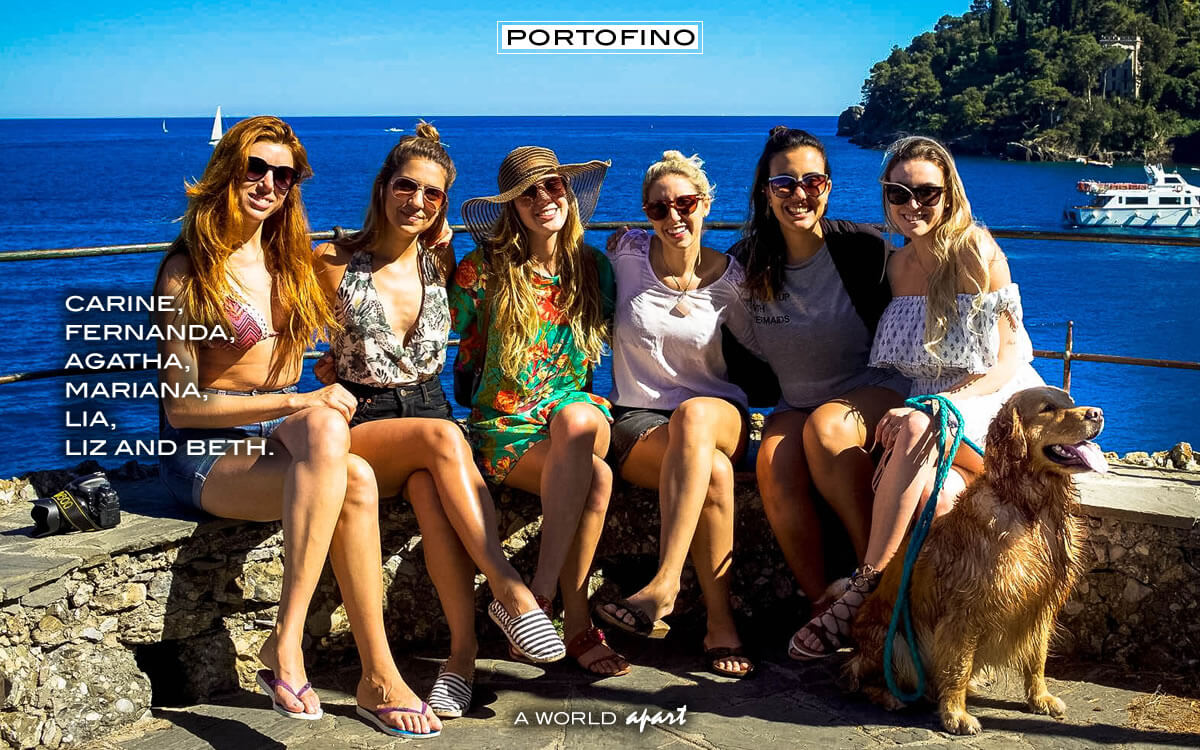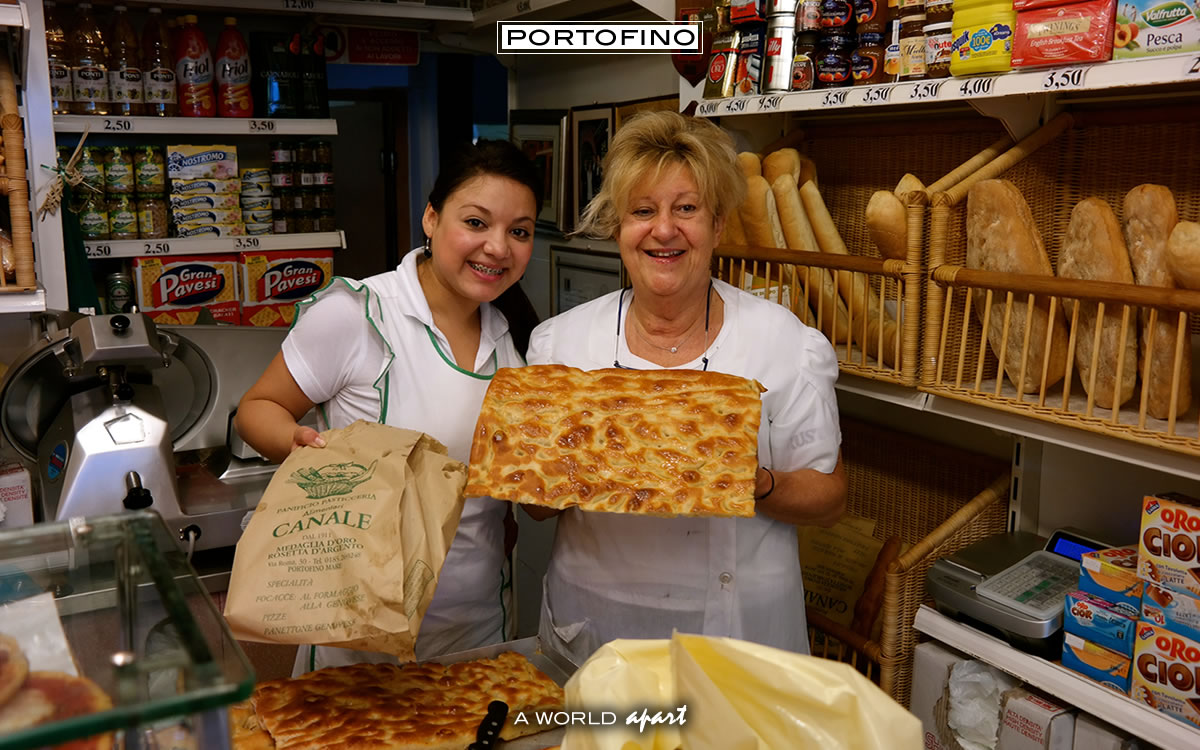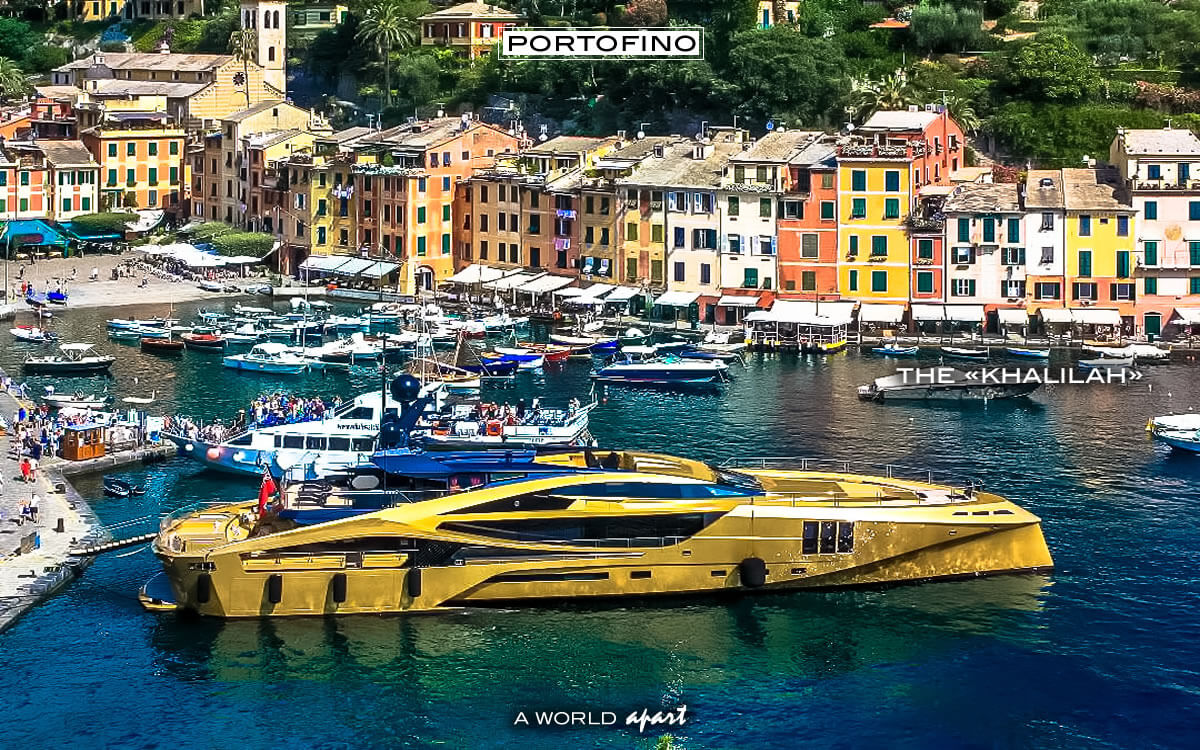
Lara enjoys the sunrise in Portofino
In previous centuries, Portofino’s public spaces have been mentioned in various literary works. From the 1800s onwards, the village boasted numerous establishments, especially when considering its diminutive size and the influx of ships at its prominent port. This port wasn’t just a hub for trade but a stopping point for notable figures like popes, emperors, politicians, and soldiers. They would often stay until favorable weather returned, boosting the demand for accommodations and food beyond the local population’s capacity.
By the late 19th century, Portofino was connected to Santa Margherita via a motor road, triggering a significant shift in the local economy. The community gradually moved from marine activities and agriculture to land-based transport and tourism. This surge in tourism led to a proliferation of shops and services, transforming the economic landscape.
One of the earliest establishments was the “Stella” restaurant, which also functioned as a boarding house. Its rooms, overlooking the Marconi Quay, remain in the Gazzolo family, descendants of the original proprietors. The Gazzolos were among the pioneers in recognizing the potential of the tourism sector. Inspired by their success, many others ventured into hotel management, restaurants, grocery businesses, and transport services.
Looking back, with the aid of old records and anecdotes from the elderly, we can piece together the commercial tapestry of Portofino. Hardworking families, with unwavering Ligurian spirit, laid the foundations for their descendants’ prosperous future. A nostalgic note: Before 1930s, Roma Street was known as the “Alley of the Souls”, named so due to its proximity to the Oratory. Locals hesitated to tread that path in the evenings, fearing the torrent and rumored evil spirits.
From the Umberto I dock, moving around the village as it was back then, there were notable establishments like the “Delfino” restaurant, “Osteria del Porto”, and the “Tripoli” restaurant. On the Peninsula, places like the “Aurora” restaurant, “Pittella”, “Gaffe Excelsior”, “Nazionale” hotel, “Roma” bar, and several grocery stores, including “Numa”, dotted the landscape. All these establishments, each with its unique story and legacy, contributed to the vibrant tapestry that was and is, Portofino.

Angi and Arlynd in the Portofino Dolce far niente!
High atop Portofino sat the “Osteria del Nan”. A Sunday favorite, particularly in winter, this spot drew crowds with its bowling green, card tables, and mouthwatering Ligurian dishes. Staples included “trenette” with “pesto” and the much-loved “tortelli” – large ravioli stuffed with locally sourced herbs and pumpkin, then fried to perfection. Post-war, this eatery became a must-visit for tourists trekking the Mount, spurring other restaurants to flourish.
Now, let me share a delightful anecdote from Portofino. Piero Moscatelli, a charismatic local who won hearts with his singing, once rescued a stray dog from the island of Giglio, naming him Bibo. The duo quickly became inseparable. Bibo, like Piero, became an instant favorite in Portofino. Their bond was such that Bibo could sense Piero’s departures and arrivals, exhibiting an uncanny knack for understanding his master’s gestures and voice over the phone.
It’s these quaint tales that make Portofino special. Speaking of local mainstays, credit must be given to the tobacconist shop owned by Giovanni Olivari and Maria Traverso. Established in the twenties, this small shop seemed to have everything under its roof – from canvas shoes to candles for All Soul Day, and from codfish oils to knick-knacks. For many, it was a one-stop haven.
Maria, in particular, was a beloved figure. Working tirelessly from dawn to dusk, her only break was a few hours on Christmas Day. Despite her dedication, she seldom ventured beyond her shop. When she finally did in 1965, courtesy of her nephew Manuel, she was amazed at the transformations around her, from the rebuilt San Giorgio church to the remodeled Carriage Square. Although she had witnessed countless interactions in her shop, she had missed the changing world just beyond her doorstep. A poignant reminder that sometimes life’s stories unfold within just a few square meters.

A lot of girls smiling in the Baia Cannone
Since the 1930s Portofino has seen significant growth in its public establishments, numbering over 50. Among these, 26 are hotels, restaurants, and snack bars. As one embarks from Umberto I dock and ventures towards Via Roma, several notable venues can be observed. This includes the American-bar restaurant “Strainer” by Enrico Vago, Vinelli’s “Pitosforo“, Gazzolo’s “Stella” which has been operational for four generations, Veto’s “Delfino“, “Tripoli” by Emanuele Viacava, “Caffe Excelsior” by Vittoria Gazzolo, Moresco’s “Sottocoperta“, Bocchio’s “San Giorgio” ice-cream parlor, and many more.
Further, descending down Dritto Alley towards Marconi Quay, one would find the “Eden” Hotel owned by Maria Osta, the “da U Batti” restaurant by Gian Bacigalupo, and the sandwich bar “l’Isolotto” by Canepa, among others. The hotel “Kulm” also emerged on Mount Portofino, popular among German tourists.
Additionally, there is the “Piccolo Hotel” owned by the Fermos, and the recently refurbished “San Giorgio” in Fondaco. “Piccolo” is set within the “Bay of the Cannon”, equipped with modern amenities, a private park, and beach access.
Via Roma in Portofino stands out with a specialty bakery known for its Genoese “focaccia“. The story of Figallo’s bakery dates back to 1911 when Giorgio Figallo and Antonia Portafo, at a young age, took over Emanuele Viacava’s “Menelik” bakers. Their journey, marred by the Italo-Turkish and First World Wars, reflects resilience and the spirit of Portofino. Antonia, fondly called “Tunitta” by locals, and Adele Devoto Ravetti, managed the bakery in Giorgio’s absence during the wars, ensuring the town’s bread needs were met.

An Aperitivo in Piazzetta – 1967
After Figallo’s return, he and his wife, through dedication and sacrifice, managed to purchase the Menelik property, where their workshop and residence still stand today. The couple had two daughters, Teresa and Emma. Emma married Maurizio Canale in 1947 and maintained the baking profession. When Canale, a savvy businessman, joined the family, he amplified the business. Today, their products are renowned globally, as evidenced by mentions in international publications like the Japanese “Asahi-Shimbun” magazine and features from California.
They even garnered a gold medal for product excellence and longevity in the business. Emma recalled that during WWII, her father, Figallo, was often displaced from his bakery, which saw consecutive occupations by the Germans, the Black Brigade, the Anglo-Americans, and eventually the South Africans. Still, in these tumultuous times, Figallo managed to produce bread for the town’s 1300 residents.
The residents had to evacuate to the mountain during this period, and bread distributions took place in the Prato locality and near Paolo de Barbieri’s tavern known as “Nan” in the San Sebastiano locality. Given that the ovens were wood-fired, one can only imagine the effort required to keep them operational. Beyond these events, acknowledgment is due to everyone who has historically brought success to their trade through their quality and entrepreneurial spirit, adding to the village’s global renown.
The Gazzolo family’s “Stella“, known for traditionally managing the village’s hospitality activities, stands as a testament to this. Their name has been part of the Portofino parish records since the 1500s, and an anecdote from the “Primo Portolano d’Italia” highlights their importance. In this anecdote, Priest G.B. Confalonieri recalls Portofino and the Gazzolo’s “Stella” hotel in 1592: “On Wednesday, 11th November 1592, we reached Portofino, just 20 miles from Genoa. We could’ve reached it by evening had the king allowed us to use the larger sails instead of just the foremast. Portofino, sandwiched between two mountains, isn’t particularly vast and faces challenges from the southeast gales which can be problematic for warships offshore.”

Immense yacht on the Baia Cannone
The quaint Village was beautifully framed by its surrounding homes. The bread available there was as white as milk, but it was underbaked and pricey, costing as much as it did in Rome. A loaf, weighing no more than four ounces, was priced at 18 coins. Moreover, a night’s rest would cost one a scudo (an ancient coin), which seemingly accounted not just for the bed but the very air one inhaled.
The village had two churches, Pieve and San Giorgio, the latter perched atop a tall mountain, which is believed to house the remains of the Saint. A mere two miles from the port was the Monastery of San Girolamo of Cervara, belonging to the Cassinesi monarch. This beautiful structure was nestled amongst the barren rocky mountains, but its vicinity was abundant with fertile produce. The monastery boasted vast gardens that yielded wheat, significant volumes of wine and oil. Any surplus was sold off. However, they couldn’t produce enough wheat to even bake bread for the breakfast of their sixteen monarchs.
“By Saturday, around two in the afternoon, after traveling along the coast for 14 miles, we reached Genoa. This coastline is dotted with numerous small castles, ports, fortifications, countless structures, enchanting gardens with panoramic vistas, and impressive establishments…”
The “Nazionale” hotel, owned by the Silvio Gazzolo family, began its journey as a tea room. Over time, it transitioned into a restaurant, and ultimately Silvio became the proprietor of a handful of small apartments, acquired through hard work and perseverance. The hotel saw its prime years in the early twenties. Mrs. Enrichetta Gazzolo in Bruno, born with a culinary flair, hadn’t received formal training, but her skills were such that she drew in a clientele comprising prelates, royalty, nobility, industrialists, and even the likes of Guglielmo Marconi.
He, with his ship “Elettra” anchored at Santa Margherita, would frequent Enrichetta’s restaurant whenever he could.
Post WWII, the most sought-after restaurant was still the “Stella.” Giorgia Cupido, a niece working alongside her uncle Italo, brought charm and adeptness in public relations to the table. Due to her widespread popularity and reputation, the common phrase shifted from “Let’s go to Stella restaurant” to “Let’s go to Giorgia’s,” underscoring her renown.
Following this, Mr. Marco Vinelli inaugurated a new restaurant on the Umbertol Dock. Having inherited an apartment with an adjoining garden, he conceived the idea of a restaurant. The Vinelli family had previously worked in the dining industry aboard the “Rex,” the fastest transatlantic ship known for its “Nastro Azzurro” recognition in 1934.
Marco aimed to introduce this expertise to Portofino, naming his restaurant “Pitosforo” due to the nearby tree. In no time, “Pitosforo” climbed the ranks to become one of Italy’s most esteemed restaurants. Initially frequented by artists and financial elites, it later drew industrialists. It’s said that numerous business deals were sealed within the confines of “Pitosforo” in Portofino.

Lo storico panificio Canale in Via Roma
Another establishment that rose to prominence, despite its long-standing history, was the “Delfino” restaurant run by the Velo brothers. Prospero Velo, who had served as the mayor of Portofino for over two decades, took an unexpected turn in his career when he became a cook. This change led to the transformation of the restaurant’s entire dynamic, making it an upscale favorite for high society. Prospero, known for his courteous and affable demeanor, introduced a myriad of delectable dishes that captured the hearts of his patrons.
There’s a particularly unforgettable taleregarding Mrs. Costanza Crovari, the owner of “Delfino”. Around 1946, Count Alfonso Bruzzo, a villa owner in the “Bay of the Cannon”, sought a night caretaker and had his sights set on Emanuele Gimelli, a boatman. He approached Costanza for background information on Gimelli. Even though Portofino was a small village where everyone was closely acquainted, Costanza diligently conducted her inquiries.
Sometime later, when the Count dined at her restaurant, Costanza approached him with her findings. She mentioned, albeit in Genoese dialect, that when the son of the famed American pilot Lindbergh was abducted, Gimelli was in America. Such tales, while humorous and seemingly far-fetched, were not uncommon in Portofino and only added to its unique charm. They reflect the tastes and preferences of its inhabitants. Today, “Delfino” stands as a premier dining establishment, attracting an elite international clientele.
The “Gritta” restaurant also played a pivotal role in bolstering Portofino’s reputation. Established in 1953 by Lorenzo Raggio, it started as an American bar located on the Marconi Quay. It quickly became a hotspot for artists and celebrities of that era. Raggio, a suave, wealthy individual, often described as a “playboy”, successfully leveraged his connections and linguistic prowess to ensure the bar’s enduring popularity. His establishment remained at the pinnacle of success until his unfortunate demise.

The Khalilah Yacht anchored on Portofino
For a significant period, the “Puny” restaurant was the talk of the town, regularly making headlines and gracing the pages of various publications. Luigi Miroli the owner, hails from a lineage of shipowners known as the “Buggi”. His artistic roots run deep, as he is the son of Evangelina Schiaffino, fondly referred to as “Vange”. Vange, herself, was the daughter of Santa, who owned an age-old eatery that once graced the Marconi Quay in the previous century. Not one to let traditions fade, Vange, in the wake of World War II, innovatively established “Al Navicello” restaurant which she, along with her family, managed for some years. Following a brief hiatus, her son, taking a cue from his family’s rich history in hospitality, returned to helm the business. With expertise and finesse, he continues to maintain the restaurant’s legacy today.
Puny attracts a clientele that shares an innate bond with Portofino, even if they belong to elite circles. Over the years, patrons’ preferences evolve, often swayed by the whims of fashion and societal norms. However, at “Puny”, excellence has always been a constant. Aside from being a skilled manager and a gracious host, Luigi Miroli has crafted an environment where guests not only relish delectable meals but also bask in the warmth of serene evenings. I vividly recall an evening when I had hosted guests for dinner at “Puny”. Their gratitude extended not only for the culinary delights but also for the enchanting company of its amiable owner.
While these distinctions are noteworthy, it’s essential to pay homage to the myriad of restaurateurs who pour their heart and soul into the culinary arts. Regardless of the scale or grandeur of their establishments, be it upscale restaurants, casual diners, or quaint grocery shops, their contributions to Portofino’s gastronomic tapestry are immeasurable. The intense yet friendly rivalry among them has birthed a plethora of mouth-watering dishes, drawing patrons back, time and again.
Who could possibly overlook the exquisite shrimp at “U Batti“, the creamy rice at “Tripoli”, the comforting soup at “Concordia”, or the delectable fish with pine nuts at “Mario’s”? These establishments, with their unparalleled food and service quality, are in a league of their own. Their success stories resonate loudly. It’s this collective spirit of all who work in Portofino, each striving to outdo the other, that crafts its illustrious reputation.
Portofino, a World apart.


